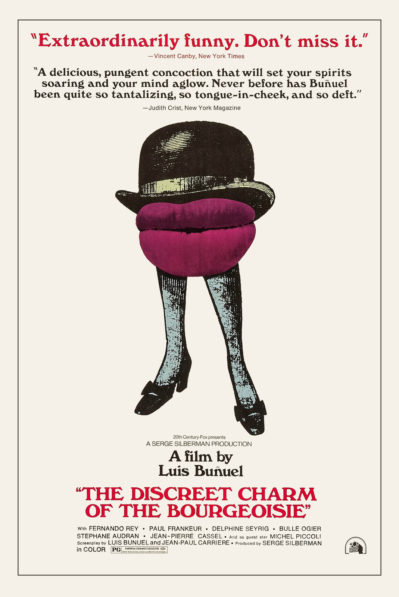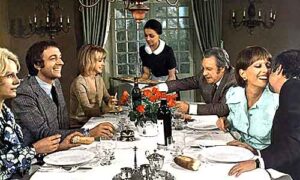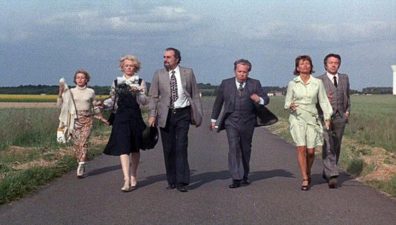A surrealist prank of a movie from the incomparable Luis Buñuel. THE DISCREET CHARM OF THE BOURGEOISIE (LE CHARME DISCRET DE LA BOURGEOISIE), Buñuel’s third-to-last film, was made in 1972, when its creator was an old man. This means it’s a far cry from earlier Buñuel provocations like UN CHIEN ANDALOU (at the premiere of which the youthful Buñuel allegedly filled his pockets with rocks to throw at what he expected would be a hostile audience) and VIRDINIANA (every copy of which the Spanish government tried to burn), offering an even-tempered and subdued run-through of many of Buñuel’s lifelong obsessions.
Buñuel’s third-to-last film, was made in 1972, when its creator was an old man.
The film, co-scripted by frequent Buñuel collaborator Jean-Claude Carrière and featuring a veritable who’s-who of early seventies French cinema (Delphine Seyrig, Jean-Pierre Cassel, Paul Frankeur, Bulle Ogier, Stephane Audran), along with Buñuel’s most prolific cast member Fernando Rey, contains what might charitably be described as a non-narrative. It’s very much in keeping with picaresque Carrière scripted Buñuel efforts like THE MILKY WAY/LA VOIE LACTEE (1969) and THE PHANTOM OF LIBERTY/LE FANTOME DE LA LIBERTE (1974), and also Buñuel’s THE EXTERMINATING ANGEL/EL ANGEL EXTERMINADOR (1962), in which a group of upper middle-class folk find themselves unable to leave a dinner party. In THE DISCREET CHARM OF THE BOURGEOISIE some wealthy Parisians repeatedly try to have dinner, but keep getting interrupted.
First the group, whose ranks include François and Simone Thévenot (Frankeur and Seyrig), the latter’s sister Florence (Ogier) and their Spanish pal Don Rafael Acosta (Rey), turn up at the country home of Alice and Henri Sénéchal (Audran and Cassel) for dinner, but are stymied by the fact that Alice claims to be completely unaware of the gathering. They elect to reconvene at a nearby inn, only to be put off by the fact that the corpse of the recently deceased manager is laid out near the dining room.
The gang try once again to dine with the Sénéchals, who keep running off to have sex. Their guests believe this means Alice and Henri are expecting the arrival of police to arrest Don Rafael for his involvement in a cocaine deal, inspiring them to dash off. But then a local bishop turns up, determined to become the Sénéchals’ gardener, and they oblige him. At this point the film’s signature image, of these six loons trudging purposefully down a country road, commences.
Next Simone, Florence and Alice attempt to imbibe at a teahouse, only to learn that its owners have run out of beverages. A further interruption arrives in the form of a soldier, who insists on relating a long-winded story (which we see dramatized) about how the ghost of his deceased mother informed him that the man the soldier thought was his father was actually an imposter, leading to a killing.
The succeeding interruptions grow increasingly outrageous, with a detachment of soldiers crashing a dinner only to be promptly called away to fight a war occurring nearby, followed by a dining room that’s revealed to be a stage upon which the diners are being viewed by an impatient audience, and a final massacre by machine gun-toting terrorists. Dreams-within-dreams also come into play in these latter scenes, with various characters waking up to reveal that everything that came before was a dream (Buñuel was a huge fan of THE SARAGOSSA MANUSCRIPT, whose influence is evident).
Included in this nutty tapestry are ghosts, gore and eroticism, yet the tone is light and unaffected throughout.
Included in this nutty tapestry are ghosts, gore and eroticism, yet the tone is light and unaffected throughout. This stems from the fact that for the first time Buñuel utilized a video monitor, which allowed for a more expansive visual tapestry than those of most of his earlier films, and a more relaxed on-set atmosphere. Yet the B-movie style Buñuel utilized on his many Mexican made melodramas of the 1950s and 60s was still in place (which reportedly frustrated his more artistically minded French collaborators).
Those of us who prefer our Buñuel films dark and subversive—such as the aforementioned EXTERMINATING ANGEL and VIRDINIANA, whose surreal air and skewering of bourgeoisie values were far more pointed than they are here—won’t be entirely satisfied by this amusing, if feather-light, trifle. It was warmly embraced by mainstream critics, and awarded Best Foreign Film by the Academy of Motion Picture Arts and Sciences—an organization Buñuel dismissed as “2500 idiots.” It’s good to know that, despite the softening of his artistic sensibilities, the elderly Luis Buñuel remained his subversive, society-bashing, surrealist self.
Vital Statistics
THE DISCREET CHARM OF THE BOURGOISE (LE CHARME DISCRET DE LA BOURGEOISIE)
Greenwich Film Production
Director: Luis Buñuel
Producer: Serge Silberman
Screenplay: Luis Buñuel, Jean-Claude Carrière
Cinematography: Edmond Richard
Editing: Hélène Plemiannikov
Cast: Fernando Rey, Paul Frankeur, Delphine Seyrig, Stéphane Audran, Bulle Ogier, Jean Pierre Cassel, Julien Bertheau, Milena Vukotic



